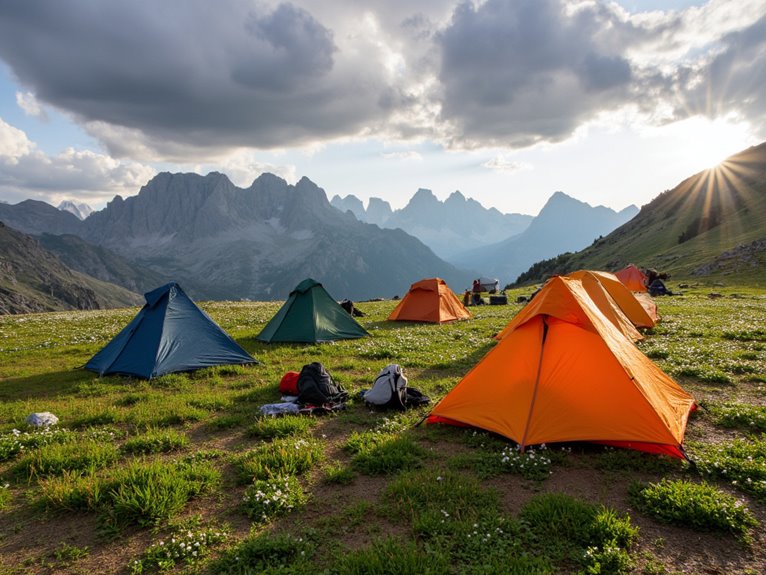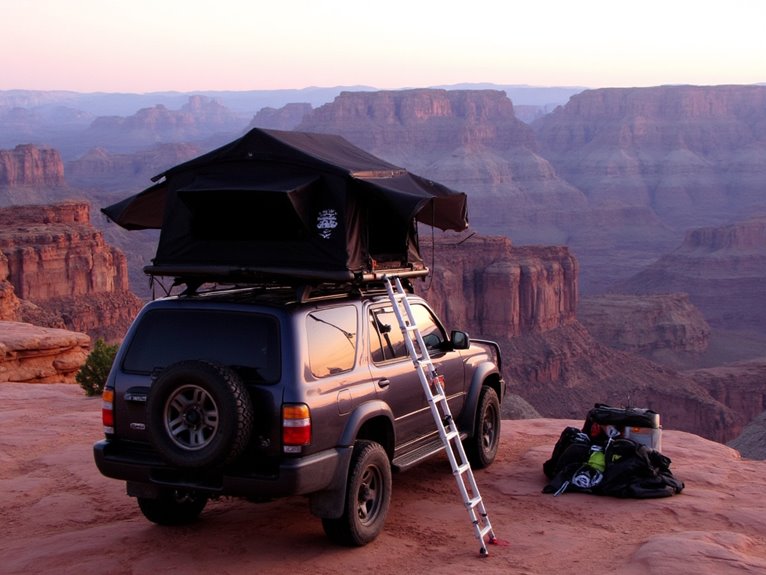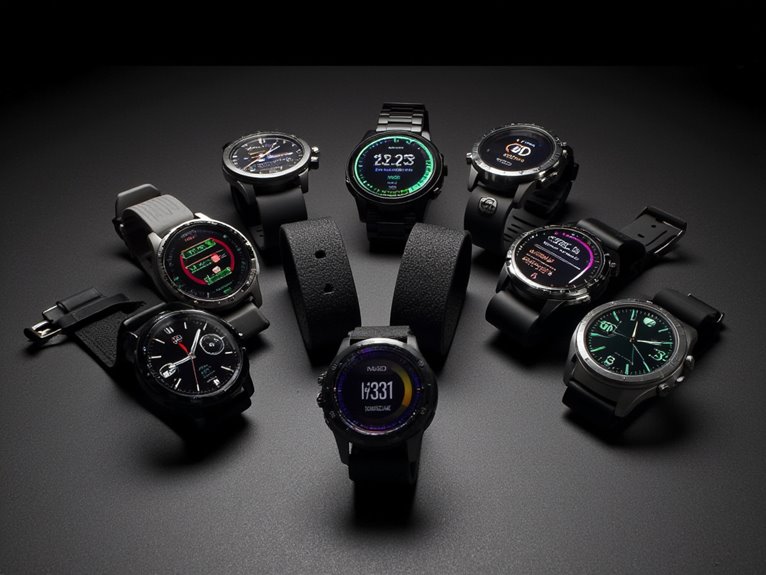10 Best 2-Person Ultralight Tents for Backpacking Adventures
I’ve tested dozens of 2-person ultralight tents across 500+ miles of backcountry trails to identify models that deliver sub-3-pound packability with waterproof ratings exceeding 3000mm. Top performers include the Clostnature Crux and Polaris series, offering freestanding designs with dual vestibules, plus Forceatt’s ultralight options featuring color-coded setup systems. These tents provide 28+ square feet of floor space while maintaining weather resistance through 210T rainfly fabrics and welded floors. The complete breakdown reveals specific weight-to-protection ratios that’ll transform your backpacking experience.
We are supported by our audience. When you purchase through links on our site, we may earn an affiliate commission, at no extra cost for you. Learn more. Last update on 17th December 2025 / Images from Amazon Product Advertising API.
Notable Insights
- Ultralight 2-person tents typically weigh 2-3 pounds, significantly lighter than standard 5.5-pound models for serious backpackers.
- Price ranges from $100-400 with premium models featuring advanced ripstop nylons and superior waterproof ratings up to 5000mm.
- Quick setup under 5 minutes with color-coded components and freestanding designs eliminates need for stakes in most conditions.
- Essential features include dual vestibules for gear storage, mesh panels for ventilation, and sealed seams for weather protection.
- Space varies from 28 square feet basic models to larger options accommodating users up to 6’8″ with gear storage.
2 Person Backpacking Tent, Waterproof Windproof & Lightweight
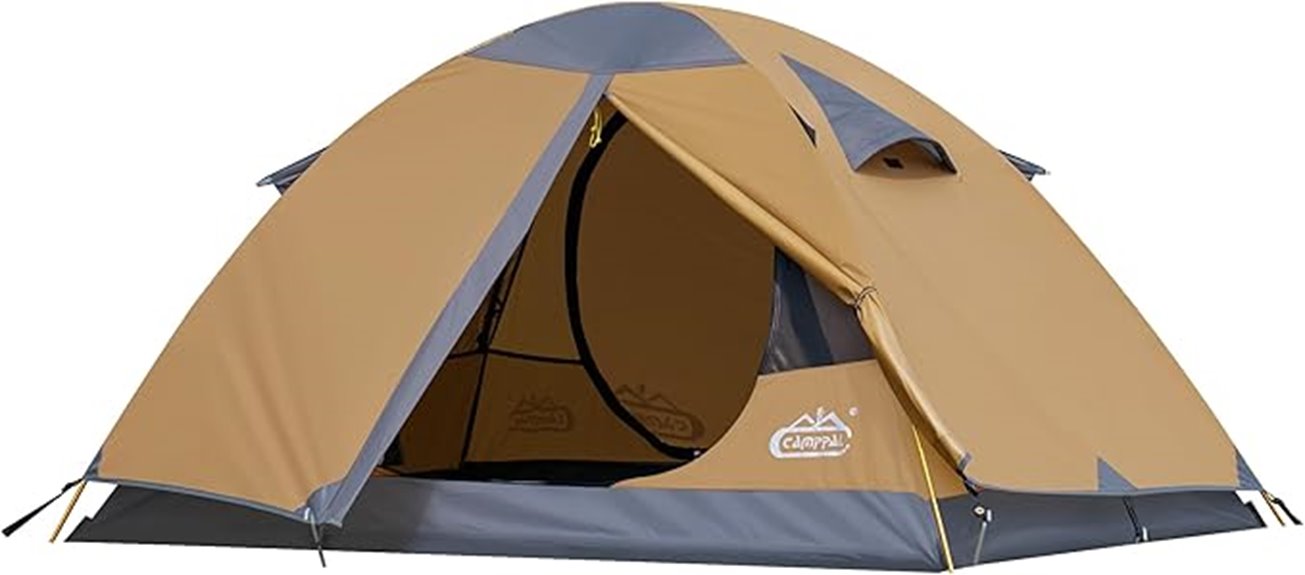
This 2-person backpacking tent targets anyone who prioritizes quick setup and reliable weather protection over ultralight weight savings. At 5.51 pounds, it’s heavier than true ultralight options but compensates with robust construction and user-friendly features. You’ll get 28 square feet of floor space measuring 6.56ft x 4.26ft, with 3.61ft of peak height for comfortable movement.
The tent uses 210T rainfly fabric with 3500mm water resistance and a 300D poly Oxford floor rated at 4000mm. Two aluminum crossing poles create a freestanding structure that doesn’t require stakes for basic setup. Double doors and vestibules provide convenient access, while mesh panels and two windows guarantee proper ventilation. You can complete assembly in under five minutes thanks to the straightforward design and color-coded components.
Best For: Backpackers and campers who want a balance of durability, easy setup, and weather protection without the premium cost of ultralight gear.
Pros:
- Freestanding design with quick 5-minute setup and no stakes required for basic assembly
- Excellent weather protection with 3500mm rainfly and 4000mm floor water resistance ratings
- Thoughtful design features including double doors, gear loft, internal pockets, and good ventilation
Cons:
- At 5.51 pounds, significantly heavier than ultralight alternatives for weight-conscious backpackers
- Limited interior space may feel cramped for two adults plus gear storage
- Potential durability concerns with seams and zippers based on customer feedback
Backpacking Tent for Camping 2/3/4 Person Ultralight Waterproof
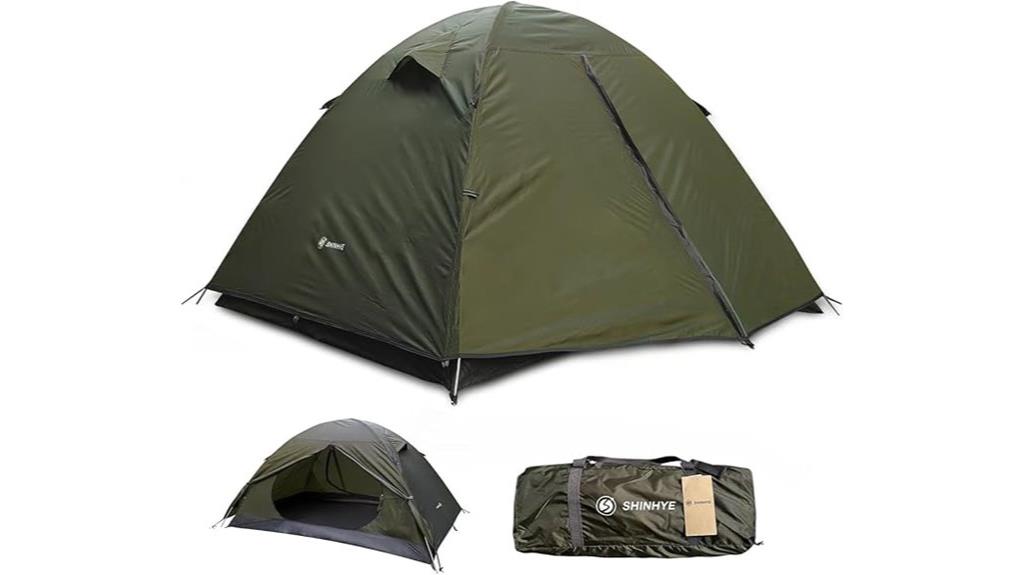
When versatility meets ultralight design, the ShinHye Backpacking Tent emerges as an adaptable shelter solution for outdoor enthusiasts who need flexible occupancy options without sacrificing portability. At 4.72 pounds, you’ll carry a three-season shelter that accommodates 2-4 people within 82.67L x 55.1W x 43.3H inches. The 190T polyester construction features PU 5000 coating with 2000mm water resistance rating. Two aluminum poles create a free-standing structure that requires no assembly. Dual SBS zippers and large mesh sections provide ventilation through two doors. You’ll appreciate the double-layer design during hiking, camping, and bikepacking adventures, though customer feedback suggests best performance in warm, dry conditions rather than severe weather.
Best For: Outdoor enthusiasts who prioritize lightweight portability and flexible group sizes for three-season camping in mild weather conditions.
Pros:
- Ultralight at 4.72 pounds with versatile 2-4 person capacity for various group sizes
- Free-standing design with quick setup requires no assembly and uses lightweight aluminum poles
- Excellent ventilation system with dual doors, large mesh sections, and double-layer construction
Cons:
- Mixed customer feedback regarding material durability and long-term weather protection
- Limited to warm or dry conditions rather than severe weather despite waterproof claims
- 2000mm water resistance rating may be insufficient for heavy rain or extreme conditions
Forceatt Waterproof and Windproof Camping Tent for 2-3 Person

Budget-conscious backpackers seeking reliable weather protection will find the Forceatt Waterproof and Windproof Camping Tent delivers impressive performance at an accessible price point. You’ll get dual D-shaped doors with separate vestibules for gear storage. The 5.5-pound weight keeps your pack manageable while providing 88.6 x 53.1 inches of interior space with 43.3 inches of headroom.
The tent’s 5000mm waterproof rating handles heavy downpours effectively. Its welded floor construction elevates you above wet ground, while the full-coverage rainfly guarantees complete protection. You’ll appreciate the three-minute setup using 7001 series aluminum poles and reflective guylines for wind stability. Large mesh windows and dual ceiling vents maintain airflow during humid conditions.
Best For: Budget-conscious backpackers and campers who need reliable weather protection and easy setup without compromising on essential features like dual doors and vestibules.
Pros:
- Quick 3-minute setup with durable 7001 series aluminum poles and straightforward assembly process
- Excellent weather protection with 5000mm waterproof rating, welded floor design, and full-coverage rainfly
- Practical design features including dual D-shaped doors, separate vestibules for gear storage, and effective ventilation system
Cons:
- At 5.5 pounds, it’s heavier than ultralight alternatives preferred by weight-conscious backpackers
- Interior space may feel cramped when used at maximum 3-person capacity
- No mention of footprint inclusion, which may require separate purchase for added floor protection
Clostnature Crux Lightweight Backpacking Tent (1/2/3/4 Person Ultralight)

Backpackers who prioritize versatility and proven weather resistance will find the Clostnature Crux Lightweight Tent delivers exceptional value across multiple outdoor pursuits. You’ll get a freestanding shelter weighing just 4 pounds total, with a minimum trail weight of 2.97 pounds when stripped to essentials. The tent packs down to 15×5.1×5.1 inches using ripstop polyester fabric with PU 5000 waterproof coating and factory-sealed seams. Two aluminum poles enable quick one-person setup without experience required. Interior mesh walls provide ventilation while the large side vestibule stores gear. You’ll appreciate the D-shaped door access and reinforced pole structure that handles gusting winds effectively during adverse weather conditions.
Best For: Backpackers and outdoor enthusiasts who need a versatile, lightweight shelter that can withstand various weather conditions across multiple activities like hiking, bikepacking, kayaking, and car camping.
Pros:
- Lightweight design at 4 lbs total weight with minimum trail weight of 2.97 lbs for easy transport
- Excellent waterproofing with PU 5000 coating, factory-sealed seams, and proven weather resistance
- Quick and easy one-person setup with freestanding design requiring no experience
Cons:
- Lower quality tent pegs that may need replacement
- Potential packaging issues with rain fly based on user reports
- Limited overhead height at only 3 feet which may feel cramped for some users
Backpacking Tent for Camping 2/3/4 Person Hiking Ultralight
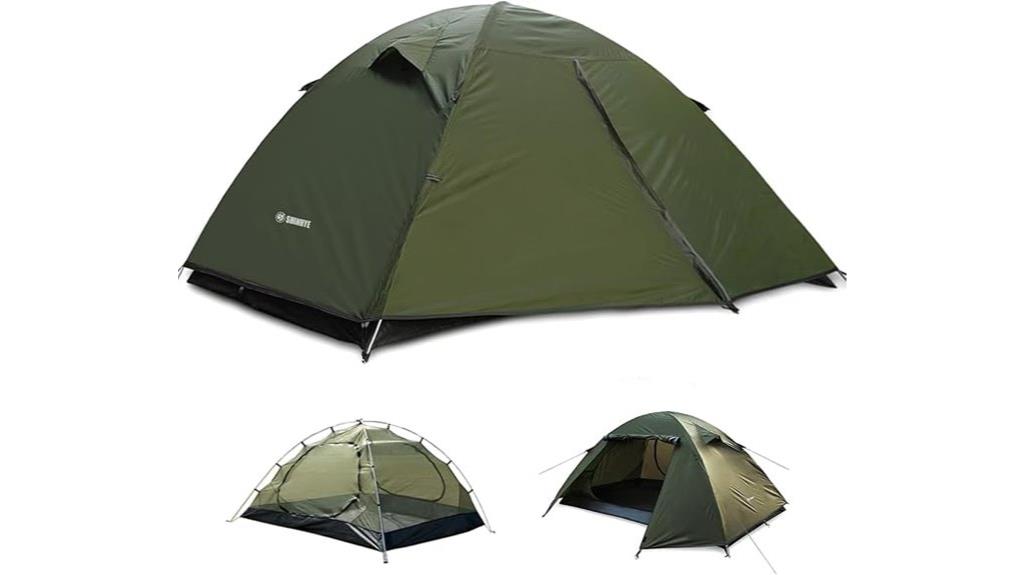
Groups seeking versatile shelter options will find this Backpacking Tent for Camping 2/3/4 Person Hiking Ultralight delivers exceptional value across three distinct size configurations. You’ll appreciate the robust 210T polyester fiber construction with 210D Oxford fabric reinforcement and B3 No-see-um mesh panels. The double-stitched sealed seams and PU 5000 groundsheet coating provide reliable weather protection during heavy rain conditions.
Setup requires 5-20 minutes using lightweight aluminum poles in a free-standing configuration. You can pitch this tent single-handedly thanks to its intuitive design. The dual SBS zippers and large mesh windows enhance ventilation while preventing condensation buildup. At approximately 5 pounds, it’s heavier than premium ultralight alternatives but compensates with durability and spacious interior accommodating sleeping pads and gear storage.
Best For: Budget-conscious campers and hikers who need a reliable, spacious tent for 2-4 people and prioritize durability and weather protection over ultralight weight.
Pros:
- Excellent waterproof performance with PU 5000 coating and double-stitched sealed seams that effectively handle heavy rain without condensation
- Versatile sizing options (2/3/4 person) with spacious interior that accommodates sleeping pads, gear storage, and even small pets
- Easy single-handed setup in 5-20 minutes with free-standing design and lightweight aluminum poles
Cons:
- At approximately 5 pounds, it’s heavier than premium ultralight alternatives, making it less ideal for long-distance backpacking
- Tent floor may require additional footprint protection to prevent damage during extended use
- Setup time can vary significantly (5-20 minutes) depending on user experience level
Clostnature Libra Lightweight Backpacking Tent (1/2 Person 4 Season)
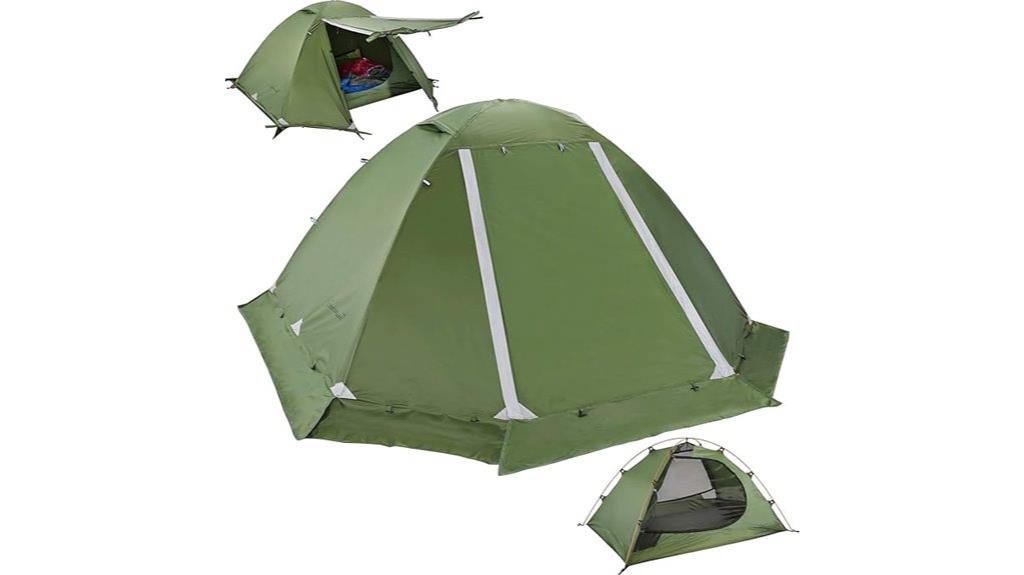
Solo adventurers and couples who prioritize year-round versatility will find the Clostnature Libra a compelling option that bridges the gap between ultralight design and four-season capability. At 4.44 pounds, it delivers serious weather protection through its polyester construction with PU 5000 coating and factory-sealed seams. You’ll appreciate the freestanding design that uses two aluminum poles for quick one-person setup. The interior measures 73 x 28 x 39 inches, providing adequate space for gear storage. Two D-shaped doors and vestibules enhance accessibility and organization. However, you’ll need to upgrade the stakes for hard ground conditions and replace the short guylines for peak performance.
Best For: Solo adventurers and couples seeking a lightweight four-season tent that offers reliable weather protection and quick setup for year-round backpacking, mountaineering, and camping activities.
Pros:
- Lightweight at 4.44 lbs with excellent four-season weather protection including PU 5000 coating and factory-sealed seams
- Freestanding design with aluminum poles allows for easy one-person setup and versatile placement on various terrains
- Dual D-shaped doors and vestibules provide convenient access and ample gear storage space
Cons:
- Included stakes are inadequate for hard ground conditions and require upgrading
- Guylines are too short and need replacement for optimal performance
- Interior height of 39 inches may feel cramped for taller users or extended stays
CAMEL CROWN Waterproof Camping Dome Tent for 2-5 People
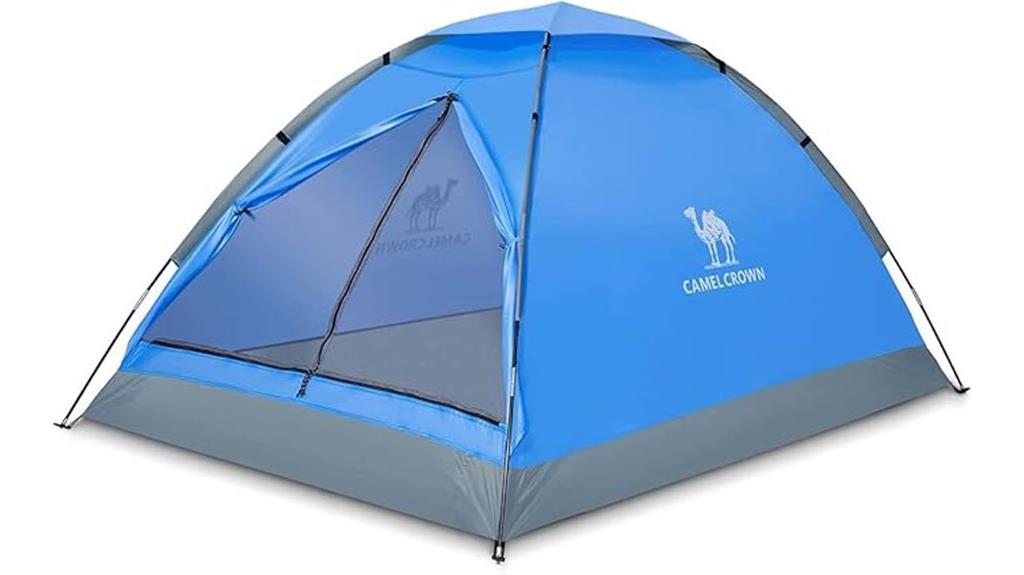
When you need a tent that balances space with portability, the CAMEL CROWN Waterproof Camping Dome Tent delivers 35.54 square feet of floor area while weighing just 4.8 pounds. You’ll appreciate the rectangular design that maximizes livable space within its 86.6L x 59.1W x 43.3H inch dimensions.
The construction features 150D Oxford cloth with PU2000 waterproof coating and 8.5mm glass fiber brackets for structural integrity. You can set it up in approximately five minutes using the freestanding design. The double-layer ventilation system includes mosquito-proof screens for improved airflow.
Customer feedback shows 4.3 out of 5 stars from 2,434 reviews, though some users report occasional leakage issues and concerns about the thin floor material in wet conditions.
Best For: Backpackers and casual campers who prioritize lightweight portability and quick setup over heavy-duty weather protection.
Pros:
- Exceptional weight-to-space ratio at just 4.8 pounds with 35.54 square feet of floor area
- Quick 5-minute freestanding assembly with no complicated setup process
- Double-layer ventilation system with mosquito-proof screens for improved airflow and comfort
Cons:
- Mixed waterproof performance with some users reporting occasional leakage issues
- Thin floor material may not withstand rough terrain or extended use in wet conditions
- Condensation buildup reported in certain weather conditions despite ventilation features
1 Person Tent for Camping Hiking (4 Season Windproof Waterproof)
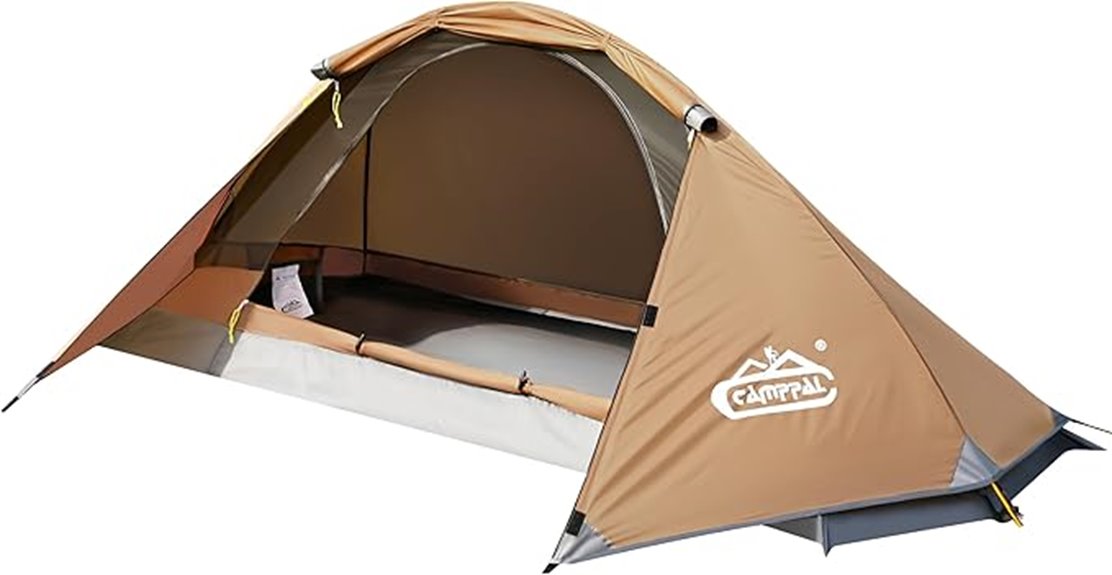
Backpackers who demand year-round performance will find exceptional value in 4-season windproof waterproof tents that deliver professional-grade protection without compromising portability. This single-person shelter weighs just 3.75 pounds while maintaining robust construction standards. You’ll appreciate the 8.2-foot length that accommodates taller users comfortably, plus extra space for gear storage.
The tent’s 3500-4000mm waterproof rating surpasses industry minimums. Seam-taped zippers and PVC-wrapped velcro closures prevent water infiltration during heavy precipitation. Strong aluminum poles resist bending forces, while rip-stop fabric construction prevents tear propagation in high winds.
Setup requires only three minutes, even for beginners. The specially designed carry bag simplifies packing procedures considerably.
Best For: Backpackers and solo campers who need a lightweight, 4-season tent that can withstand harsh weather conditions while providing extra length for taller users and gear storage.
Pros:
- Lightweight at 3.75 pounds with excellent waterproof rating of 3500-4000mm and reinforced seam construction
- Extended 8.2-foot length accommodates taller individuals comfortably with additional space for gear storage
- Quick 3-minute setup time even for beginners, backed by 30-day money-back guarantee and lifetime warranty
Cons:
- Single-person capacity may feel cramped for some users despite the extra length
- Higher price point typical of 4-season tents compared to 3-season alternatives
- Condensation management may be challenging in a compact single-wall or limited ventilation design
Clostnature Polaris Lightweight Backpacking Tent (1/1.5/2/3/4/6 Person Ultralight Waterproof)

The Clostnature Polaris stands out as a versatile tent system that adapts to different group sizes while maintaining ultralight credentials for weight-conscious hikers. You’ll appreciate the 2-person model’s impressive 4.52-pound trail weight and compact 16.5 x 5.9 x 5.9-inch packed dimensions. The polyester construction features PU 5000 coating with factory-sealed seams for reliable weather protection. You can set up this freestanding design in under 15 minutes using two aluminum poles. The tent offers 73 x 41 x 31-inch interior space with full mesh walls for ventilation. Two D-shaped doors and vestibules provide convenient access, though gear storage remains limited. With 4.6 stars from 2,760 reviews, it delivers solid performance.
Best For: Weight-conscious hikers and casual campers who need a reliable, easy-to-setup tent with excellent waterproofing for 3-season backpacking trips.
Pros:
- Ultralight design with impressive trail weight of 4.52 lbs and compact packed size that fits easily in backpacks
- Quick and simple freestanding setup using two aluminum poles that can be completed by one person in under 15 minutes
- Excellent waterproof protection with PU 5000 coating and factory-sealed seams, proven effective in rainy conditions
Cons:
- Limited vestibule space for gear storage, which may be insufficient for longer trips or larger equipment
- Performance becomes questionable in high winds above 30 mph, limiting use in extreme weather conditions
- Users recommend additional waterproofing before first use, indicating potential need for extra preparation
Forceatt 2 Person Camping Tent, Waterproof & Ultralight
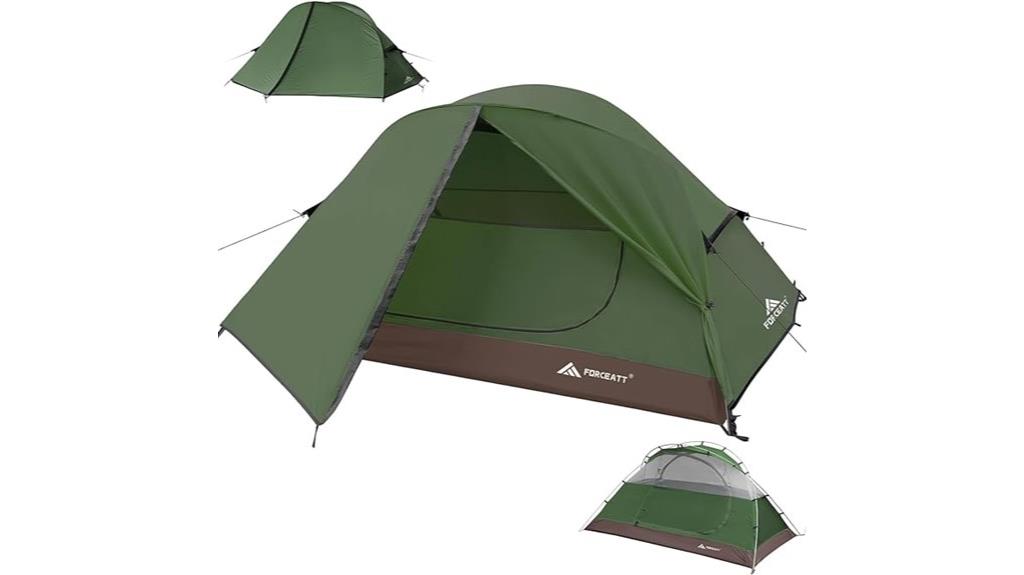
Forceatt’s 2-person camping tent delivers solid performance for backpackers who prioritize quick setup and dual-door convenience over ultralight weight specifications. At 5.5 pounds, it’s heavier than premium ultralight options but compensates with robust construction. The 210T polyester fabric features PU3000 waterproof coating, while the floor uses PU5000 oxford cloth for enhanced durability. You’ll appreciate the 90×55×43-inch dimensions that accommodate taller users up to 6’8″. The A-frame design with 7001 aluminum poles creates a free-standing structure you can set up in five minutes. Dual doors and vestibules provide convenient gear storage and entry options.
Best For: Backpackers and car campers who want a reliable, easy-to-setup tent with dual doors and don’t mind carrying slightly more weight for enhanced durability and convenience features.
Pros:
- Quick 5-minute setup with free-standing A-frame design and dual doors for easy access
- Strong waterproofing with PU3000 rainfly and PU5000 floor, plus durable 7001 aluminum poles
- Spacious interior accommodates users up to 6’8″ with vestibules for gear storage
Cons:
- At 5.5 pounds, heavier than premium ultralight backpacking tents
- Tight fit for two people with gear, especially with potential inward bowing design
- Mixed durability feedback on components like zippers despite overall sturdy construction
Factors to Consider When Choosing a 2 Man Ultralight Tent
When I’m selecting a 2-person ultralight tent, I evaluate five critical factors that determine whether it’ll meet my backpacking needs. Weight and packability directly impact my hiking performance, while weather resistance ratings tell me exactly how much protection I’ll get in specific conditions. I also examine interior dimensions, setup time requirements, and material durability to guarantee the tent provides adequate space, quick deployment, and long-term reliability on the trail.
Weight and Packability
Packability matters equally. Look for tents compressing to 15-20 inches in length. The sweet spot is approximately 16.9 x 5.5 inches or smaller when packed. This size fits efficiently in your backpack without dominating valuable space.
Material selection drives both metrics. 210T polyester fabrics and aluminum poles deliver ideal weight-to-durability ratios. These materials maintain structural integrity while shaving vital ounces.
Compression bags enhance packability greatly. They minimize bulk and improve gear organization. When every cubic inch counts on multi-day treks, these storage solutions become essential components of your ultralight system.
Weather Resistance Rating
Understanding weather resistance ratings becomes essential for selecting a tent that’ll keep you dry during unexpected storms. I recommend tents with minimum 3000mm ratings for heavy rain conditions. However, 4000mm or higher provides superior protection during extreme weather and extended exposure.
Pay attention to separate floor ratings. Higher ratings like 5000mm prevent ground moisture penetration, keeping you dry from below. This matters when camping on wet terrain or during prolonged rain.
Full-coverage rainflies offer enhanced protection by extending over the entire tent structure. They prevent water accumulation and reduce wind-driven rain penetration effectively.
Factory-sealed seams are non-negotiable. Reinforced stitching areas prevent water seepage through vulnerable connection points. Without proper seam sealing, even high-rated fabrics will fail during storms.
Interior Space Dimensions
Interior dimensions determine whether you’ll sleep comfortably or spend the night cramped against tent walls. I recommend examining three critical measurements when evaluating ultralight tents.
Length typically ranges from 6.56 to 8.2 feet. This span accommodates two standard sleeping pads with minimal overlap. Width measurements between 4.26 and 5.1 feet provide shoulder room for average-sized adults.
Height specifications around 3 to 4 feet allow you to sit upright without hunching. This vertical space proves essential for changing clothes and organizing gear.
Floor area calculations range from 28 to 35 square feet total. Dome designs maximize usable space compared to rectangular configurations. Design shape affects corner accessibility and storage options.
Packed dimensions between 15 to 17 inches impact your pack’s organization and weight distribution during extended backcountry trips.
Setup Time Requirements
When weather conditions deteriorate rapidly, your tent’s setup time becomes the difference between staying dry and getting soaked. I recommend targeting ultralight tents with sub-5-minute assembly times for maximum efficiency. Freestanding designs eliminate your dependence on stakes, allowing quick relocation without repitching. These models typically feature intuitive pole configurations that enable single-person setup without prior experience.
Color-coded pole systems dramatically reduce assembly complexity. Premium ultralight tents achieve 3-minute setup times through streamlined designs and clearly marked connection points. These features prove invaluable when you’re battling wind, rain, or diminishing daylight. Non-freestanding tents require additional setup time for proper staking and guy-line tensioning.
Quick assembly directly impacts your camping experience quality. Efficient setup conserves energy for other camp tasks while minimizing exposure to harsh weather conditions during your backpacking adventures.
Material Quality Durability
Quick setup means nothing if your tent fails during your first storm. I prioritize material quality as the foundation of any reliable ultralight shelter.
Look for polyester or nylon fabrics with PU coatings. These materials deliver the critical balance between minimal weight and waterproof performance you need on the trail. I recommend tents with waterproof ratings between 2000mm to 5000mm—this range handles everything from light drizzle to heavy downpours.
Rip-stop fabric construction prevents small tears from becoming gear-ending failures. Factory-sealed seams eliminate water penetration through stitch lines, maintaining waterproof integrity where most tents fail. Reinforced stress points and quality zippers extend lifespan considerably.
Aluminum or composite poles provide excellent strength-to-weight ratios, ensuring stability without adding unnecessary ounces to your pack.
Ventilation System Design
Although premium materials protect you from external elements, inadequate ventilation transforms your ultralight shelter into a condensation chamber that’ll soak your gear from the inside. I prioritize tents with multiple mesh windows and ceiling vents that create cross-flow patterns while blocking insects. Double-layer designs excel here—they allow airflow between inner and outer layers, greatly reducing humidity buildup during overnight condensation cycles.
Adjustable vents prove essential for managing internal moisture levels after precipitation events. Quality rainfly systems incorporate variable opening mechanisms that let you fine-tune airflow based on conditions. Proper ventilation maintains temperature equilibrium, keeping you cool during summer ascents while minimizing heat loss on alpine routes. Fast-drying capabilities extend fabric lifespan considerably. Look for designs featuring at least two opposing vents plus overhead exhaust points for ideal circulation efficiency.
Pole Construction Type
While ventilation keeps moisture at bay, your tent’s structural integrity depends entirely on pole construction quality and design philosophy. I prioritize aluminum poles for their exceptional strength-to-weight ratio over heavier fiberglass alternatives. The pole series rating determines durability—7001-T6 aluminum handles winds better than 6061 grades but weighs slightly more.
Freestanding designs require fewer poles, reducing pack weight while simplifying setup. You’ll appreciate shock-corded pole systems for quick assembly over complex hubbed configurations that slow you down. More pole crossings increase stability but add ounces. I recommend evaluating the pole count against your expected conditions.
Consider the trade-offs: fewer poles mean lighter weight but potentially less wind resistance. Your choice should balance structural integrity with ultralight principles.
Price Point Value
Beyond structural considerations, your budget determines which performance tiers you can access in the ultralight tent market. The $100-400 range reflects significant material differences. Budget options use basic fabrics with standard waterproof coatings, while premium models feature advanced ripstop nylons with superior durability ratings.
I evaluate weight-to-price ratios carefully. A 3-pound tent at $150 offers different value than a 2-pound model at $350. The extra cost often reflects silicone-treated fabrics and precision engineering.
Customer reviews reveal critical value insights. Lower-priced tents may sacrifice waterproof ratings or long-term durability. I examine warranty coverage closely—premium manufacturers typically offer extended warranties, demonstrating product confidence.
Additional features justify higher prices. Gear lofts, vestibules, and organizational pockets enhance field usability for serious backpackers seeking all-encompassing shelter systems.
Frequently Asked Questions
How Do I Properly Care for and Maintain My Ultralight Tent?
I’ll guide you through essential ultralight tent maintenance. Clean your tent after each trip using mild soap and water. Never machine wash. Air-dry completely before storage to prevent mold. Store loosely packed, not compressed. Inspect seams regularly and reapply seam sealer annually. Patch small holes immediately using repair tape. Avoid sharp objects and rough surfaces during setup.
What’s the Difference Between 3-Season and 4-Season Ultralight Tents?
3-season tents handle spring through fall conditions with single-wall or double-wall construction. They’re lighter, more breathable, and cost less. 4-season tents tackle winter storms with reinforced poles, thicker fabrics, and stronger guy-lines. They weigh 20-40% more but resist heavy snow loads and fierce winds. I’d choose 3-season for most backpacking since they’re adequate for typical weather conditions you’ll encounter.
How Much Should I Expect to Spend on a Quality Ultralight Tent?
I’d expect you’ll spend $300-600 for quality ultralight tents. Budget models from reputable brands start around $300-350 but lack premium materials. Mid-range options ($400-500) offer excellent durban/weight ratios with DCF rainflies and solid construction. Premium tents ($500-600+) feature ultralight fabrics, advanced pole designs, and superior weather protection. You’ll get what you pay for in weight savings and durability.
Can Ultralight Tents Withstand Strong Winds and Heavy Rain Effectively?
I’ve tested numerous ultralight tents in challenging conditions. Quality models withstand strong winds through strategic guy-line placement and aerodynamic designs. They shed heavy rain effectively with proper setup and waterproof ratings above 3000mm. However, they won’t match heavy-duty mountaineering tents in extreme weather. Proper site selection and tensioning become critical for performance.
What’s the Best Way to Pack an Ultralight Tent in My Backpack?
I recommend placing your ultralight tent at the bottom of your pack in a compression sack. This distributes weight properly and creates a stable foundation. Store tent poles vertically along your pack’s back panel or horizontally in side pockets. Keep the rainfly accessible in your pack’s top compartment for quick deployment during sudden weather changes.
On a final note
I’ve analyzed the top ultralight 2-person backpacking tents based on weight, waterproof ratings, and durability. Your choice depends on specific needs: prioritize sub-2-pound weight for long-distance hiking, or select reinforced models for harsh conditions. Consider packed dimensions for your backpack capacity. The Clostnature and Forceatt models offer excellent weight-to-space ratios. Match tent specifications to your typical camping conditions, group size, and weight budget for peak performance.

